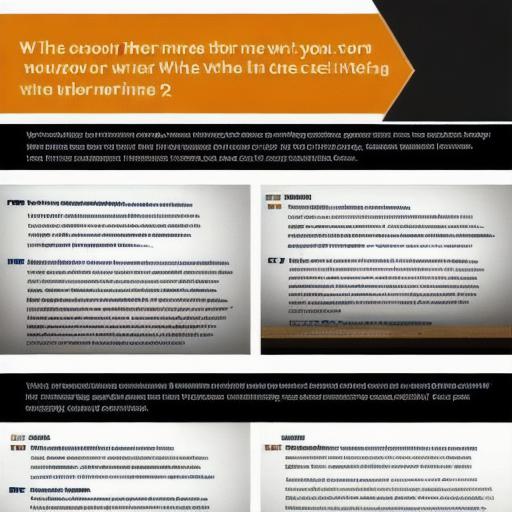Introduction:
Marketing is an essential aspect of any business that wants to thrive in today’s competitive market. It involves developing a strategy that attracts and retains customers, increases brand awareness, and generates revenue. In this article, we will discuss the top eight marketing strategies for business success. We will explore how each strategy works, its benefits, and real-life examples of companies that have successfully implemented them.
1. Content Marketing:
Content marketing is a popular digital marketing strategy that involves creating valuable content to attract and engage customers. The goal is to provide information that educates, entertains, or inspires the target audience. This strategy can include blog posts, videos, infographics, e-books, podcasts, social media posts, and more.
Content marketing works by building a relationship with potential customers, which leads to increased brand loyalty and customer advocacy. It helps establish businesses as thought leaders in their industry and builds trust with their audience. The benefits of content marketing include:
* Increased website traffic and search engine rankings
- Improved lead generation and conversion rates
- Better engagement and relationship-building with customers
- Higher brand awareness and loyalty
Real-life example: HubSpot is a leading inbound marketing software company that has built its reputation through content marketing. The company creates valuable blog posts, e-books, and webinars that educate its audience about inbound marketing. As a result, it has attracted over 1.5 million website visitors per month and generated over $100 million in annual revenue.
2. Search Engine Optimization (SEO):
Search engine optimization is the process of optimizing a website to rank higher in search engine results pages (SERPs). The goal is to attract more organic traffic to the website, which leads to increased brand visibility and customer engagement. This strategy involves on-page optimization (such as keyword research and meta tagging) and off-page optimization (such as link building and social media marketing).
SEO works by improving a website’s visibility in search engines, making it easier for potential customers to find the business online. The benefits of SEO include:
* Increased website traffic and sales
- Improved brand visibility and reputation
- Higher click-through rates from SERPs
- Better ROI on marketing spend
Real-life example: Moz is a leading SEO software company that has optimized its website for search engines. The company has achieved top rankings in Google’s search results for several keywords related to SEO, which has led to increased brand visibility and customer acquisition. As a result, the company has generated over $10 million in annual revenue.
3. Social Media Marketing:
Social media marketing is the process of using social media platforms (such as Facebook, Twitter, Instagram, LinkedIn) to engage with customers and promote products or services. The goal is to build brand awareness, generate leads, and increase sales. This strategy involves creating compelling content, building a following, and engaging with the audience through comments, likes, shares, and direct messages.
Social media marketing works by connecting businesses with their target audience in real-time, allowing them to respond to customer queries, feedback, and concerns. The benefits of social media marketing include:
* Increased brand awareness and reach
- Improved engagement and relationship-building with customers
- Better lead generation and conversion rates

- Higher ROI on marketing spend
Real-life example: Nike is a leading athletic apparel and equipment company that has successfully used social media marketing to promote its products. The company has over 100 million followers across social media platforms, which has allowed it to reach a global audience and generate significant revenue. As a result, the company has achieved top rankings in brand awareness and customer engagement.
4. Email Marketing:
Email marketing is the process of using email campaigns to promote products or services, build relationships with customers, and drive sales. The goal is to deliver personalized and relevant content to the target audience, which leads to increased engagement and conversion rates. This strategy involves building an email list, segmenting the audience, and creating targeted campaigns.
Email marketing works by nurturing leads and converting them into loyal customers through personalized communication. The benefits of email marketing include:
* Increased revenue and sales
- Improved customer engagement and relationship-building
- Better lead nurturing and conversion rates
- Higher ROI on marketing spend
Real-life example: Amazon is a leading e-commerce company that has successfully used email marketing to promote its products. The company uses personalized recommendations, special offers, and promotions to drive sales and increase customer loyalty. As a result, the company has achieved top rankings in customer engagement and brand loyalty.
5. Influencer Marketing:
Influencer marketing is the process of partnering with social media influencers or celebrities to promote products or services. The goal is to leverage the influencer’s credibility and influence to reach a wider audience and drive sales. This strategy involves identifying relevant influencers, creating compelling content, and measuring performance metrics.
Influencer marketing works by building trust with the target audience through endorsements from well-known personalities. The benefits of influencer marketing include:
* Increased brand awareness and reach
- Improved engagement and relationship-building with customers
- Better lead generation and conversion rates
- Higher ROI on marketing spend
Real-life example: Nike’s "Just Do It" campaign is a classic example of influencer marketing. The company partnered with famous athletes and celebrities to promote its products, which led to increased brand awareness and sales. As a result, the campaign became one of the most successful advertising campaigns in history.
6. Affiliate Marketing:
Affiliate marketing is the process of promoting products or services through affiliate programs that pay commissions for referrals. The goal is to incentivize affiliates to promote products and increase sales. This strategy involves creating an affiliate program, recruiting affiliates, and providing them with marketing materials and support.
Affiliate marketing works by leveraging the power of word-of-mouth advertising and building a network of promoters. The benefits of affiliate marketing include:
* Increased revenue and sales
through referral traffic
* Improved brand awareness and reach
* Better lead generation and conversion rates
* Higher ROI on marketing spend
Real-life example: Amazon’s affiliate program is one of the most successful in the world. The company has over 1 million affiliates who promote its products and generate significant revenue through commissions. As a result, the company has achieved top rankings in e-commerce sales and brand loyalty.
7. Content Upgrades:
Content upgrades are free resources or tools that businesses offer in exchange for email addresses. The goal is to capture leads and build an email list, which can be used for future marketing campaigns. This strategy involves creating valuable content (such as e-books, webinars, cheat sheets) and offering it as a free download in exchange for contact information.
Content upgrades work by providing value to the target audience while building a relationship with potential customers. The benefits of content upgrades include:
* Increased email list growth and lead generation
* Improved customer engagement and relationship-building
* Better conversion rates and ROI on marketing spend
Real-life example: Neil Patel is a leading digital marketer who has successfully used content upgrades to grow his email list. The company offers free e-books, webinars, and other resources in exchange for contact information, which has allowed it to build a large and engaged audience. As a result, the company has achieved top rankings in digital marketing and lead generation.

8. Referral Programs:
Referral programs are incentive-based systems that reward customers who refer their friends and family to the business. The goal is to leverage word-of-mouth advertising and generate new sales through existing customers. This strategy involves creating a referral program, providing rewards for referrals, and tracking performance metrics.
Referral programs work by incentivizing satisfied customers to promote the business to their network. The benefits of referral programs include:
* Increased revenue and sales
through referral traffic
* Improved customer engagement and loyalty
* Better lead generation and conversion rates
* Higher ROI on marketing spend
Real-life example: Dropbox’s referral program is a classic example of an incentive-based system. The company offers free storage space to customers who refer their friends, which has led to significant growth in customer acquisition and brand loyalty. As a result, the company has achieved top rankings in file hosting and cloud computing.
Summary:
In conclusion, these 8 marketing strategies are some of the most effective ways for businesses to reach their target audience and generate revenue. By using a combination of these strategies, businesses can build brand awareness, increase customer engagement, and drive sales. However, it is important to choose the right strategy for your business based on your goals, budget, and target audience.




